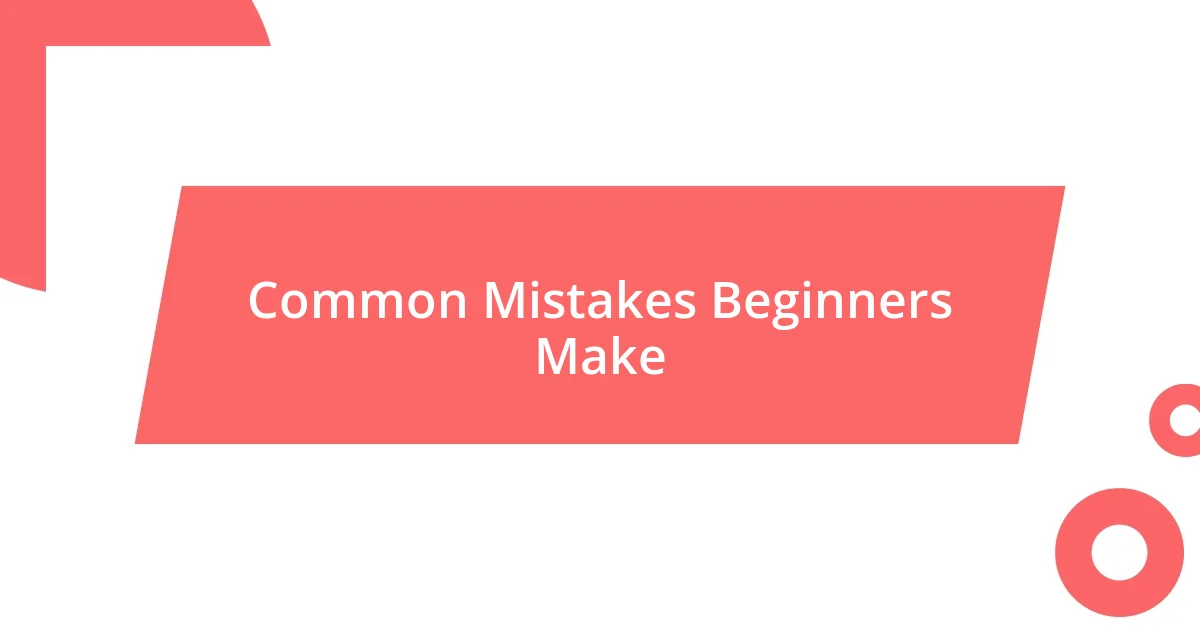Key takeaways:
- Mastering breathing techniques and stroke mechanics significantly improves swimming efficiency and enjoyment.
- Swimming skills are essential for personal safety, health benefits, and social opportunities.
- Choosing the right gear and staying aware of one’s limits in the water are crucial for safe and effective swimming.

Understanding the Basics of Swimming
Understanding the basics of swimming involves grasping essential techniques and body movements. For me, the moment I first glided through the water, I felt an exhilarating mix of freedom and fear—can you relate to that feeling? Mastering your breath is crucial; I remember gasping for air initially, but with practice, I learned to exhale underwater and inhale at the surface, which transformed my experience.
One of the most vital aspects is body position. I struggled with keeping my hips up when I first started, causing my legs to drag and slow me down. Have you ever felt that awkward sinking sensation? I found that focusing on a streamlined position not only improved my speed but also made swimming feel more effortless and enjoyable.
The importance of stroke technique cannot be understated. When I transitioned from learning the freestyle stroke to mastering the backstroke, it felt like discovering a new world. It made me wonder—how often do we limit ourselves by sticking to what’s comfortable? Embracing different strokes expanded my skills and enhanced my confidence in the water, showing me that there’s so much more to swimming than just getting from point A to B.

Importance of Swimming Skills
Swimming skills are more than just a fun pastime; they are essential for safety and personal growth. I still remember the first time I felt nervous near deep waters. Knowing how to swim provided me with the confidence to enjoy the beach without fear. It’s a skill that can turn a potentially dangerous situation into a moment of joy and freedom.
Here are a few reasons why swimming skills are crucial:
- Safety: Swim skills can literally save your life in emergencies.
- Health Benefits: Regular swimming enhances cardiovascular fitness and strengthens muscles.
- Stress Relief: There’s something therapeutic about being immersed in water that calms the mind.
- Social Opportunities: Swimming can connect you with others, whether through classes, teams, or casual meet-ups at the pool.
- Lifelong Skill: Once you learn, it’s a skill that stays with you through life, allowing you to enjoy countless aquatic activities.
Every time I see someone conquer their fear of the water, it reminds me of my own journey—a journey where confidence replaced anxiety, and each splash in the water felt like a celebration of overcoming my limitations.

Common Mistakes Beginners Make
Many beginners make the mistake of forgetting to warm-up before hitting the water. I remember my first few swim sessions when I just dove in without stretching, and boy, did I feel it later! Warming up can improve flexibility, enhance performance, and prevent injuries, so taking a few minutes to prepare your body goes a long way.
Another common error is not paying attention to breathing. In the early days, I often struggled with this—taking quick inhales and holding my breath underwater. It wasn’t until I focused on a rhythmic breathing pattern that I finally felt comfortable and efficient in the water. Have you ever felt out of breath while swimming? It’s crucial to find your breathing rhythm to maintain stamina and make your swim enjoyable.
Lastly, I see beginners frequently neglecting proper stroke technique. When I first learned freestyle, I had a tendency to pull with my arms only, which led to excessive fatigue. I discovered that engaging my core and using my legs more effectively helped propel me through the water. Without a doubt, mastering stroke mechanics can transform your swimming experience, helping you move more gracefully while conserving energy.
| Common Mistakes | Consequences |
|---|---|
| Skipping Warm-Ups | Increased risk of injuries and decreased performance |
| Poor Breathing Technique | Shortness of breath and fatigue while swimming |
| Neglecting Stroke Mechanics | Excessive effort leading to exhaustion |

Effective Techniques for Breathing
Breathing in swimming is often overlooked, yet it’s crucial for an enjoyable experience. When I first started, I would gulp for air between strokes, completely losing my rhythm. It wasn’t until I practiced exhaling through my nose while my face was in the water that everything clicked. This simple adjustment transformed my swimming sessions, allowing me to swim longer without feeling out of breath.
I also discovered the importance of timing my breaths. One of my most memorable swim practices was when I consciously worked on taking a breath with every third stroke. This not only kept my head aligned with my body but also helped maintain my speed. Have you ever tried swimming with a specific breathing pattern? It can feel awkward at first, but the sense of control it brings is exhilarating. You might find that you’re able to swim further without feeling fatigued, which makes all the difference.
Lastly, I can’t stress enough the role of relaxation in your breathing technique. I still recall a particular swim where I was so tense that my breaths were shallow and quick, making me more exhausted than usual. Learning to relax my shoulders and find a calm state of mind made each inhale feel like a refreshing boost. If you take a moment to notice your body while swimming, you’ll realize how much smoother your strokes can be when your breathing is calm and steady. Isn’t that a game changer?

Tips for Improving Stroke Efficiency
Improving stroke efficiency is all about fine-tuning each movement you make in the water. One technique I’ve found invaluable is the catch phase of my stroke. When I first learned to swim, I didn’t fully engage my hand and forearm to ‘catch’ the water. But once I started to think about my hand entering the water fingertips first and extending forward, I was amazed at how it propelled me further with less effort. Have you ever noticed how small changes can lead to such big improvements?
Another aspect that really transformed my efficiency was focusing on my body position. In the beginning, I would let my legs drag behind me, causing unnecessary resistance. By consciously keeping my body flat and my hips high in the water, I became more streamlined. The simple act of envisioning my body as a straight line made a huge difference—my strokes felt lighter, and I found I could swim longer distances without getting tired. Does that imagery resonate with you?
Finally, don’t overlook the significance of a strong kick. When I was first learning to swim, I treated my legs as almost an afterthought. It wasn’t until I added consistent flutter kicks that I noticed a boost in my overall propulsion. I remember feeling a rush of excitement the first time I realized I could glide through the water with my legs actively driving me forward. Just think about it: the right balance of arm movement and leg power can provide a rhythm that feels almost effortless once you get the hang of it. Isn’t that worth striving for?

Choosing the Right Swimming Gear
Choosing the right swimming gear can feel like a daunting task—especially when you’re just starting out. I recall my first trip to the swim shop, feeling overwhelmed by the choices. I remember standing in front of those colorful swimsuits, unsure which one would give me the best experience. It hit me then: comfort should always be your priority. Selecting a suit that fits well not only boosts your confidence but also allows for freedom of movement, making each swim more enjoyable.
Another essential component to consider is the type of goggles you wear. Believe me, investing in a good pair can significantly enhance your underwater vision. I made the mistake of using cheap goggles early on, and fogging up mid-lap was a frustratingly frequent occurrence. After getting a higher-quality pair with anti-fog technology, it was like having a new lease on my swimming sessions. Have you ever felt the joy of clear sight while gliding through the water? It’s liberating!
Finally, don’t forget about accessories like swim caps and fins, which can be game changers in your swimming journey. I was initially skeptical about wearing a swim cap; it felt unnecessary. But once I tried it, I realized how much it reduced drag and kept my hair out of my face. Then there were the fins—I underestimated how they could help with my kick and overall technique. They not only strengthened my legs but also gave me that little boost to improve my confidence. Have you ever thought about how the right accessories can elevate your skills? They truly can make a difference.

Staying Safe While Swimming
Staying safe while swimming is crucial, and I’ve learned this through experience. Early in my swimming journey, I felt invincible in the water, but after a close call where I underestimated the current, I realized how important it is to respect the strength of natural bodies of water. Have you ever found yourself in a situation where you had to quickly assess the conditions? It’s important to understand that what might feel like a calm lake can turn unexpectedly dangerous on a windy day.
Another key point is to know your limits. I remember pushing myself too hard during a swim, determined to go just a bit further. As I got fatigued, panic set in, and it was a tough moment for me. That experience taught me the values of listening to my body. I can’t stress enough that swimming should be enjoyable! So, set realistic goals, especially when swimming in unfamiliar environments.
Lastly, never underestimate the power of swimming with others. I can think back to countless fun-filled days at the pool or beach with friends. There’s an undeniable comfort in having a buddy nearby, not just for safety, but for moral support. If something were to happen, having someone there can make a world of difference. Have you ever felt that collective sense of security among fellow swimmers? It’s comforting to know you’re not alone out there, and it truly enhances the experience.












